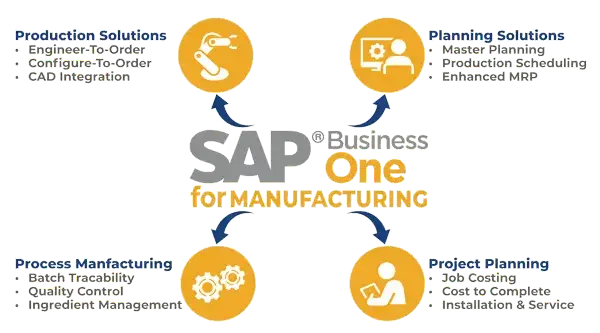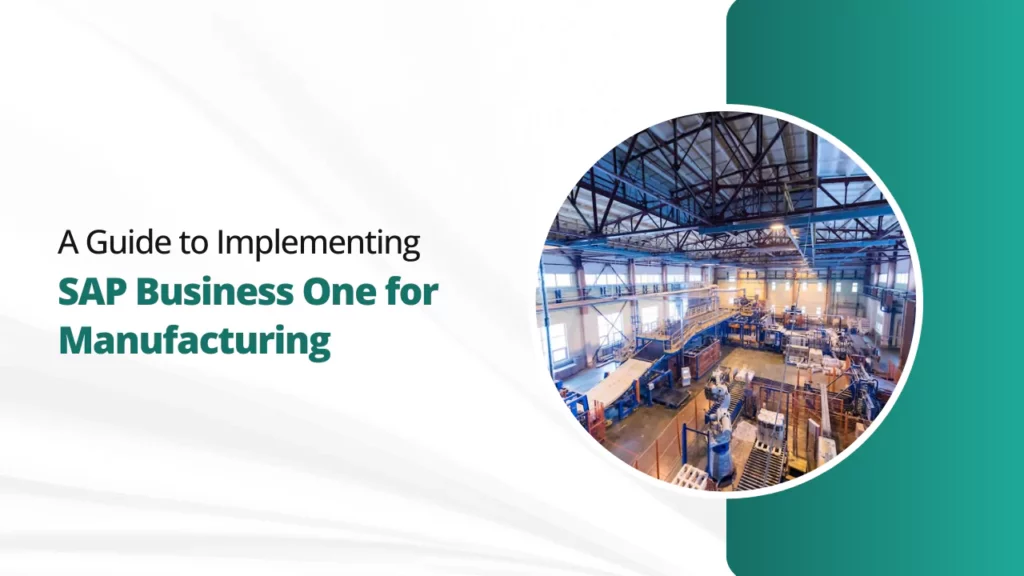SAP Business One is a powerful ERP solution that has specific features for the manufacturing industry. It helps manufacturers to manage operations, enhance productivity, and achieve manufacturing excellence. Implementing SAP Business One for manufacturing can be a complex process, but it can also be a rewarding one. In this guide, we will explain the essential steps for implementing SAP Business One in the manufacturing industry.
SAP Business One for Manufacturing
SAP Business One is a scalable and customizable ERP system. It provides manufacturers with the tools to manage every aspect of their operations. SAP Business One offers a holistic solution for manufacturers seeking a competitive edge. It helps with inventory management, production planning, order processing, and financial control.

Why Manufacturers Need SAP Business One for Manufacturing
Manufacturers face a multitude of challenges in today’s competitive landscape. These challenges include:
- Fluctuating customer demands
- Increasing production complexity
- The need for real-time data analysis
SAP B1 addresses these challenges by providing a platform for managing manufacturing processes.
Key Features and Benefits of SAP Business One
Here are some of the key features and benefits of SAP Business One
- Simplified Operations: SAP B1 simplifies complex manufacturing operations. This feature reduces the likelihood of errors and delays.
- Inventory Control: Real-time tracking of inventory levels, reducing overstock and understock situations.
- Quality Control: Ensures consistent product quality and adherence to industry standards.
- Customization: Tailor the system to your unique manufacturing processes.
- Data Analytics: Gain insights from data to make informed decisions.
Steps to Implementing SAP Business One in Manufacturing
Follow these steps to implement SAP Business One for manufacturing:
1. Assess Your Manufacturing Processes
The first step is to conduct an assessment of your current manufacturing processes. Identify pain points, bottlenecks, and areas for improvement.
2. Set Clear Objectives
Establish clear and measurable objectives for the implementation of SAP Business One. Determine what you aim to achieve and how success will be measured.
3. Choose the Right SAP Business One Partner
Selecting the right implementation partner is crucial. Look for a partner with experience in manufacturing.
4. Data Migration and Integration
Transfer existing data into SAP Business One. Ensure smooth integration with other systems and processes.
5. Employee Training and Change Management
Prepare your team for the change by providing training and support. Effective change management is critical to a successful implementation.
6. Testing and Quality Assurance
Test the system to ensure it aligns with your objectives and requirements. Address any issues that arise during testing.
7. Go-Live and Post-Implementation Support
Transition to the live environment with adequate support. Post-implementation support ensures that any issues are resolved.
Common Challenges and How to Overcome Them
Implementing SAP Business One for manufacturing can come with various challenges. Here are some common challenges related to the implementation of SAP Business One, along with strategies to overcome them:
1. Data Migration:
- Challenge: Migrating existing data into the new system can be complex and time-consuming. Data may be in different formats or scattered across various sources.
- Strategy: Plan the data migration, ensuring data accuracy and consistency. Consider working with experts in data migration to streamline the process.
2. Integration Issues:
- Challenge: Integrating SAP Business One with existing systems can lead to compatibility issues.
- Strategy: Collaborate with experienced integration specialists who can ensure a smooth transition. Focus on a thorough testing phase to identify and address integration challenges.
3. Scope Creep:
- Challenge: It’s typical for the project scope to expand beyond the initial plan. This can cause delays and budget overruns.
- Strategy: Define project objectives and scope from the outset. Establish a change management process to assess and approve any scope changes.
4. Lack of Expertise:
- Challenge: Implementing SAP Business One may need the expertise that your organization lacks.
- Strategy: Collaborate with an experienced SAP Business One consultant. Their expertise can reduce the learning curve and mitigate risks.
5. Quality Assurance:
- Challenge: Ensuring the system performs as expected can be a challenge.
- Strategy: Establish a comprehensive testing plan, including quality assurance checks. Test the system under various scenarios to identify and resolve any issues.
6. Project Management:
- Challenge: Managing the implementation project to keep it on track can be challenging.
- Strategy: Appoint an experienced project manager to oversee the project. Use project management tools and methodologies to complete tasks on time.
7. Training:
- Challenge: Inadequate training can stop the adoption of SAP Business One by your team.
- Strategy: Create comprehensive documentation and training materials. Conduct regular training sessions to ensure that all users understand the system.
8. Post-Implementation Support:
- Challenge: After the system goes live, ongoing support is crucial. It is required to address any issues and make necessary adjustments.
- Strategy: Establish a support system or contract with a support provider. Check the system’s performance and user feedback regularly.
The Impact of SAP Business One on Manufacturing Efficiency
Using SAP Business One for manufacturing has a profound impact on efficiency. SAP Business One helps manufacturers reduce costs, improve product quality, and enhance productivity. This powerful ERP solution empowers manufacturers to make data-driven decisions. It can forecast demand and ensure consistent product quality. As a result, it leads to more efficient and competitive manufacturing operations.
Conclusion
Using SAP Business One for manufacturing is the best way to improve operational efficiency. However, it requires careful planning, the right partners, and ongoing support. Your manufacturing business can thrive if you follow the correct guide.
If you are looking for a partner to help you implement SAP Business One for manufacturing, contact us. We have the tools and experts to do the best for your business.




